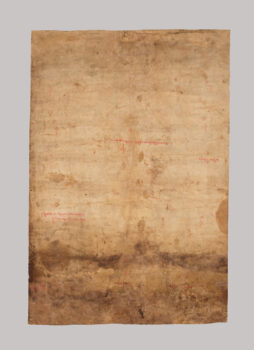Tibet
19th century


Tibet
19th century


This deity embodies female power and the wisdom of understanding the ultimate reality as explained in Buddhist tantric teachings. Her appearance and skull adornments highlight the unconventional nature of tantric practices and help practitioners cultivate non-attachment and contemplate impermanence and the absence of self (ego). Vajrayogini has three eyes and appears semi-wrathful, baring her teeth. She drinks from a skull cup while holding a flaying knife in her outstretched hand. A staff (katvanga), topped by three heads and a scepter (vajra), rests on her left shoulder. It symbolizes her absent consort Chakrasamvara. Vajrayogini stands naked with her feet pressed down on gods who signify obstacles. She is surrounded by teachers and sources of transmission lineage. Below her lotus pedestal are protector deities of the tradition.
A religious movement that originated in India around the fifth to seventh century with sacred writings and esoteric teachings and practices transmitted from teacher to student through initiation. These remain an important part of Hinduism and Buddhism today.
In Buddhism gender is considered more fluid compared to some other religions. Certain traditions emphasize the importance of all genders in achieving enlightenment. The feminine is considered an embodiment of wisdom and the masculine is an embodiment of method.
Prescribed practices that carry symbolic meaning and value within a specific tradition and are intended to attain a desired outcome. Rituals are usually done as part of a ceremony or regular routine.
Get the latest news and stories from the Rubin, plus occasional information on how to support our work.